Several factors are driving innovation in marine shipbuilding, with among the most important ones being the Clean Air Act and subsequent EPA and CARB regulations. In some cases, standards were set before the technology to meet those goals could be developed.
Another factor is the need for high-speed vessels with novel missions, such as in wind farm development. This article looks at recent and upcoming propulsion systems within the context of a sampling of new vessels.
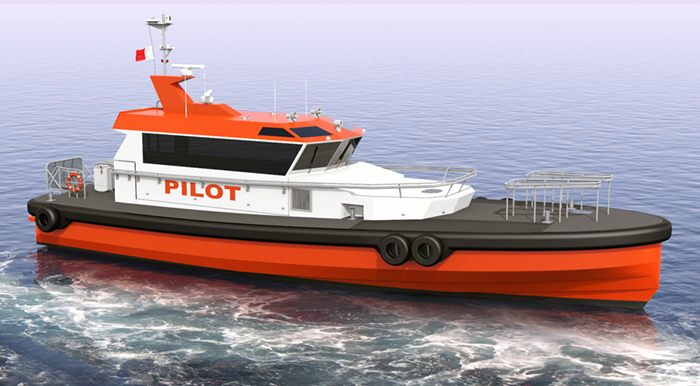
San Francisco Bar Pilot Boat, Designer: Camarc Design, UK, Builder: Snow & Company, Seattle WA
Snow & Company, Inc. of Seattle, Wash. is currently building a 67-foot x 19-foot all-aluminum pilot boat for San Francisco Bar Pilots, the group that navigates large ships through waterways throughout the Bay Area. The new pilot boat is expected to be the first Tier 4 pilot boat built in the United States. It will also feature Camarc Design’s latest evolution hull, with enhanced efficiencies and comfort.
The UK design firm is known for its pilot specific hulls with balanced all-around seakeeping capability, proven on over 160 dedicated pilot boats worldwide. Powering will be provided by twin MAN D2862 LE 438 EPA Tier 4 marine engines rated for 1,200 HP at 2100 rpm each with MAN SCR exhaust after-treatment systems supplied by Northern Lights Power and Energy, formerly known as RDI Marine.
Power from the MAN D2862 LE 438 runs through TwinDisc MGX 6599 SC reduction gears to twin HamiltonJet HTX52 water jets, which is also a new model offered by HamiltonJet. The jets will sport Hamilton’s fully integrated AVX control system, which offers class-leading dual redundancy and compact modules for optimum bridge layout and ergonomics.
When delivered in late 2022, the vessel’s expected to operate 24/7 in the central San Francisco Bay waters, plus transfer pilots to and from the offshore pilot station vessel 11 miles west of the Golden Gate Bridge.
“We chose the Tier 4 MAN D2862 engine for its outstanding power to weight ratio with a high power density and compact installation dimensions,” Capt. David McCloy of San Francisco Bar Pilots explained to Pacific Maritime.
“Our vessels must also comply with the new California Commercial Harbor Craft emissions regulations and the MAN engine has small and flexible SCR components, quite suitable for a high speed pilot vessel of this size,” he said. “The Hamilton HTX52 water jets will give us excellent application of power and enhanced maneuverability.”
“The team at Snow & Company, along with Camarc Design, has worked closely with our pilot association to develop a high quality vessel,” McCloy said.
“Snow & Company is extremely excited about the opportunity to build this world class pilot boat for the San Francisco Bar Pilots,” business development Vice President Tim Kolb said. “The uniqueness of the selection of the propulsion system highlights the vessel’s strengths and performance for its intended operation.”
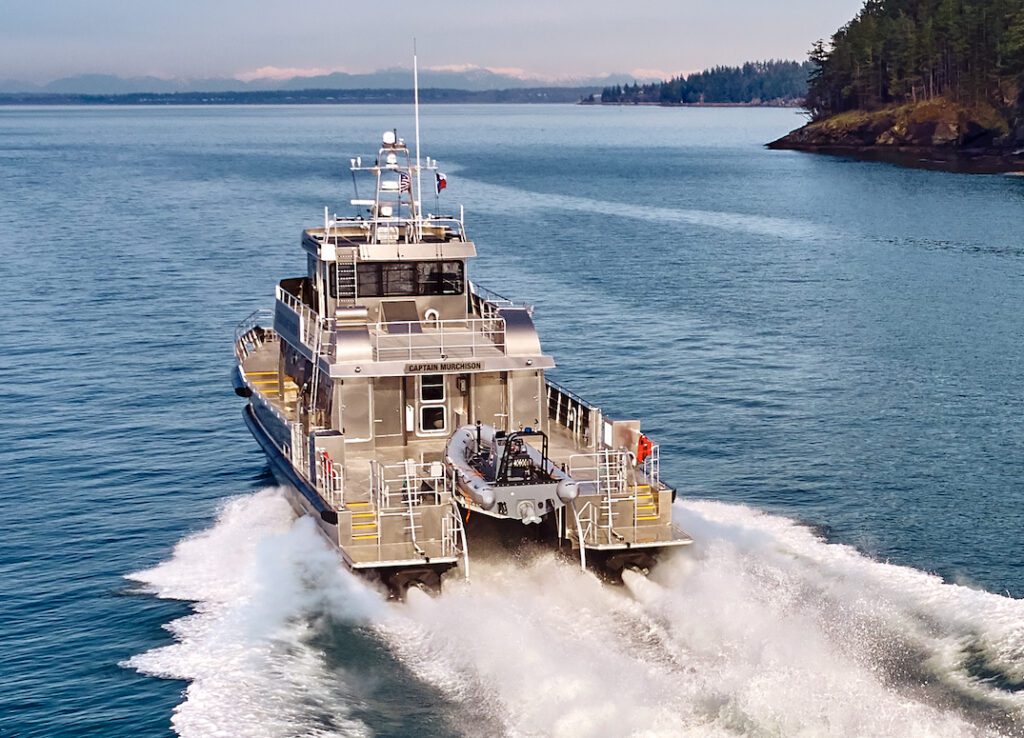
Captain Murchison, Naval architect: Nic de Waal, Teknicraft Design, NZ, Builder: All American Marine in Bellingham, WA
All-American Marine recently delivered the 80-foot x 27-foot catamaran patrol craft Captain Murchison to the law enforcement division of Texas Parks and Wildlife Department. The vessel was designed to work not only Texas coastal waters but also federal waters beyond the limits of the 200-nautical mile Exclusive Economic Zone.
According to the builder, the hydrofoil-assisted aluminum vessel is capable of 27 knots cruising, 30 knots maximum with the best fuel consumption possible for the given parameters of its mission in and around the Gulf of Mexico, with uncertain weather and sea conditions.
After a rigorous Computational Fluid Dynamics, the design team concluded that the best propulsion system for this vessel was provided by twin turbo-charged CAT C18 ACERT (Advanced Combustion Emissions Reduction Technology) D engines generating 873 horsepower each passed through two 665 ZF gearbox to the two HamiltonJet HM 521 jets.
The Captain Murchison was the first vessel in North America to incorporate HamiltonJet’s new AVX control system which, according to HamiltonJet, “enables the seamless integration of skipper assistance, autonomous, electrification and digitalization technologies” for station keeping and JETanchoring positioning.
The 20-foot RHIB is powered by a 170 hp Volvo Penta diesel engine and Hamilton Jet propulsion.
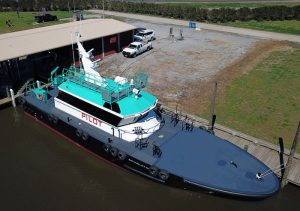
Spindletop, Designer: Breaux’s Bay Craft and C. Fly Marine Services, Builder: Breaux’s Bay Craft Loreauville, LA
Spindletop, now among the largest pilots boat in the United States, was recently delivered to Sabine Pilots Services in Port Arthur, Texas by Breaux’s Bay Craft of Loreauville, La. The 90-foot by 23-foot by 12-foot aluminum pilot boat uses the same New Generation deep-V hull first used on a vessel for Tampa Bay Pilots in 2019.
Propulsion comes from a QUAD Scania DI16-082M DI16-082-M diesel, four 800 hp engines turning through Twin Disc MGX-5146 marine gears to power four HamiltonJet HM461 jets. Scania has said that it takes a modular approach to power and includes a cylinder design that produces less NOx and particulate matter. The result, according to the company, is better efficiency for every drop of fuel used, both in terms of economy and emissions.
The QUAD Scania D116-82-M engine blocks are made of compacted graphite iron (CGI), which is lighter and has twice the tensile strength as gray iron, according to the maker.
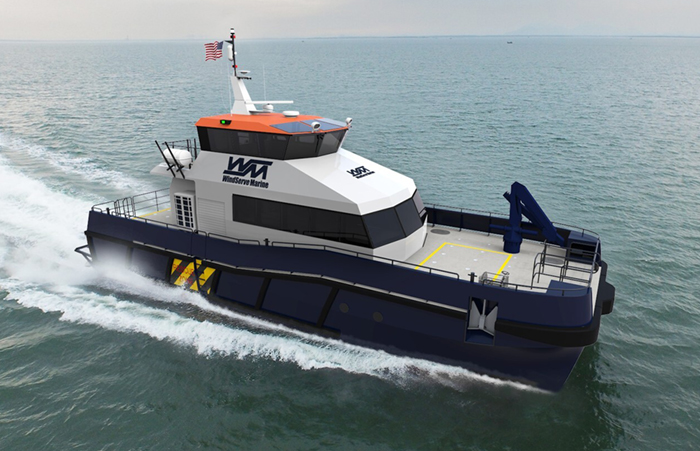
WindServe Odyssey, Designer: BMT Group, Builder: Senesco Marine, North Kingston RI
WindServe Odyssey is a 64-foot by 23-foot multi-purpose offshore support catamaran for the nascent wind farm industry in the United States. Propulsion on the all-aluminum vessel comes from a QUAD Scania DI16-082M DI16-082-M diesel engine channeled through four ZF Marine 655s to four HamiltonJet HM 461 jets.
The Quad Scania concept is that as many engines as needed at a given time can deliver all the power needed; this can result in better responsiveness, but lower fuel consumption through redundancy. An alternative would be twin 1,600 hp engines with aftertreatment to meet emission standards, according to the company.
Scania has also said that its individual cylinder heads weigh in at only 40 lbs., allowing a single technician to do everything to their engines in the vessel; no A-frame is needed to do a simple valve clearance check.
Having so much parts-commonality means it’s always easier to have the right parts in stock, according to the company, which adds that it usually has better than a 98% first pass fill rate from the Scania warehouse, which is located near the UPS headquarters in Louisville, Kentucky.
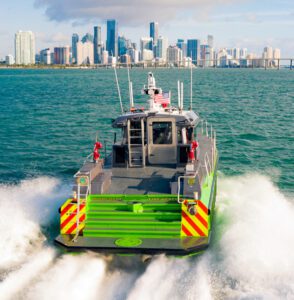
Miami-Dade Fire Rescue (MDFR) FB-73, Designer/builder: Metal Shark, Jeanerette, LA
FB-73 and its twin FB-21 are monohull fireboats powered by twin V8, 16-liter, 1,200-horsepower MAN D2862 LE456 inboard diesel engines coupled to Marine Jet Power (MJP) 350X waterjets via ZF500 transmissions.
Both MDFR vessels have top speeds in excess of 44 knots, according to Metal Shark. The MJP 350X water jet features a cast aluminum bucket that cast aluminum bucket designed for decreased stopping distance and increased maneuverability.
MJP has recently announced three new sizes in the X-Series range of waterjets; expanding upon the 280, 310 and 350 X sizes, the new 400, 450 and 500 X feature MJP’s duplex stainless-steel, mixed-flow pump design and welded aluminum intake.
The new additions to the range will service vessels that are larger and more powerful than FR-73, according to Metal Shark, which added that high-speed applications appropriate for the X-Series include fast patrol craft, military applications as well a commercial work boats and search and rescue vessels.
“The new 400, 450 and 500X waterjets are a new era for MJP,” X-Series Product Manager Adam Mills told Pacific Maritime. “We can now offer X-Series on larger vessels up to 40m, helping shipyards to streamline the installation process saving them time and money, while reaping the benefits of a high performing, mixed-flow, duplex stainless-steel waterjet at a lower price point.”
